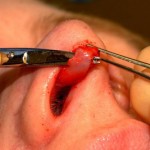‘For the most part I like my nose, but I have a slightly rounded, bulbous tip. I don’t really want to change my nose, just tweak it a little bit and give the tip of my nose slightly more definition.’
‘I have a decent nose. However, as I’ve gotten a little older, I noticed the tip of my nose has became more rounded and less defined. I wanted a “tweak” to refine the nose.’
These are common statements that I have heard in my Indianapolis plastic surgery practice from patients seeking nose changing surgery. Often in rhinoplasty, patients are concerned about one specific feature of their nose that they don’t like. As a plastic surgeon, I am trained and experienced to see the entire nose and how it relates to the rest of their face. This perspective allows me to offer suggestions about other changes to the nose that may also be beneficial. However, it is important to respect a patient’s concerns, particularly if they are concrete about one specific change. After all, patient’s know their own nose the best and they have to live with the result.
The tip may be the smallest third of the external nose by surface area but it is the complex. Its shape and angulation has a profound impact on nasal and facial appearance. It is the one feature of the nose that is the most unique between every person.
A tip rhinoplasty is a variety of operative manuevers that seeks to change the volume, angle, or height of the nasal tip. Alterations can range from simple to complex, depending on the degree and scope of an individual patient’s problem. Many different outcomes are possible, depending on both the patient’s desires and the plastic surgeon’s aesthetic sense.
Anatomically, a tip rhinoplasty involves changing the relationship of the lower lateral (alar cartilages) with the upper lateral cartilages and the caudal (end) of the  septum. It can be as ‘simple’ as a cephalic trim, a reduction of the upper part of the bulbous tip cartilage, or more involved with adjustment of the septum at its base and grafts placed between the nasal ala to enhance and rotate the tip. Various types of techniques, including suture modification, cartilage excision, or structural grafting may be used to achieve the desired aesthetic outcome.
Most commonly when a patient refers to tweaking the nose, they usually mean making it a little narrower (more refined) or lifting it just a bit or both narrowing and a little lift combined. Such changes can be done through either an open or closed approach. When the changes are small, I prefer a closed or endonasal approach to lessen the duration of time that the patient has to endure the surgical swelling.
When modifying the tip of the nose, it is critical to not ‘over tweak’ it. This means to not make the tip into a single point (too narrow) or lift it too high or short. When this happens one will have an operated look which is synonymous with having had one’s nose done which is¦exactly what patients are trying to avoid.
Barry L. Eppley, M.D., D.M.D.
Indianapolis, Indiana




